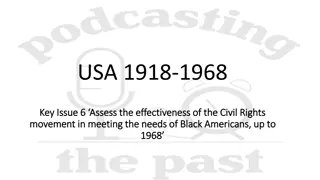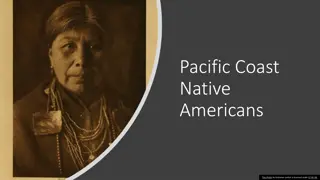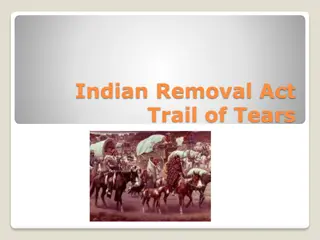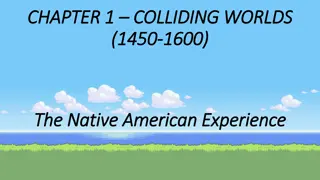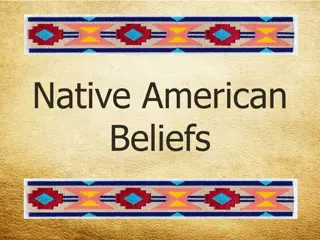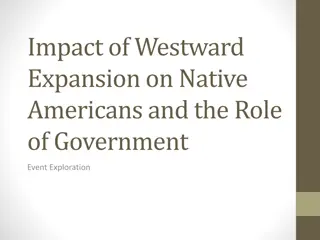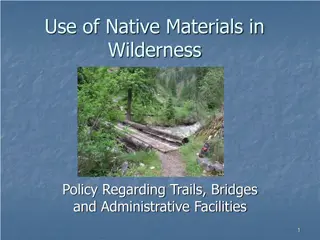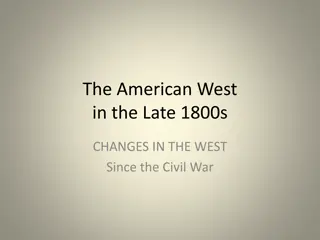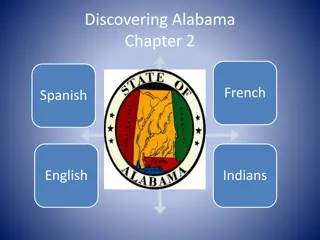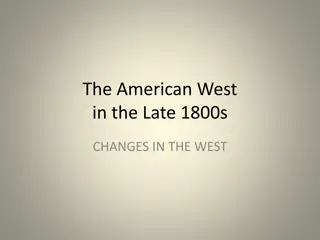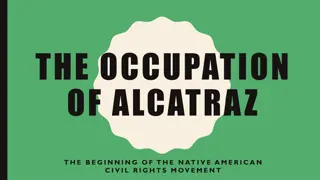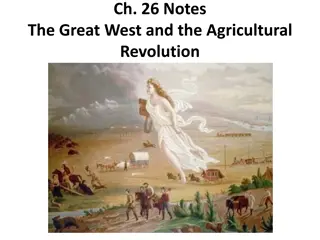ReuNify: A Comprehensive Analysis of React Native Android Apps
ReuNify is a program analysis project targeting React Native Android applications. It integrates JavaScript and native-side code into Jimple, facilitating static analysis. The tool addresses the challenges posed by the complex mechanisms of React Native and the transition to Hermes bytecode. With a
3 views • 24 slides
Understanding Invasive Species in Northwest Michigan
Explore the impact of invasive species in Northwest Michigan through images and data on habitat support for butterfly and moth species, the transition of non-native plants to becoming native, and the definition of what makes a species invasive. Learn about the threats posed by non-native species and
4 views • 15 slides
The Effectiveness of the Civil Rights Movement in Meeting the Needs of Black Americans up to 1968
Assessing the impact of the Civil Rights movement on Black Americans up to 1968 reveals significant progress in ending racial discrimination and segregation, securing voting rights, and advocating for social and economic equality. Despite achievements like the Civil Rights Act of 1964 and the Voting
0 views • 36 slides
Uncovering the Past: Indigenous History of the Delmarva Peninsula
Delve into the rich indigenous history of the Delmarva Peninsula, acknowledging the injustices and hardships faced by Native American communities. From Columbus' invasion to the Trail of Tears, explore the impact of colonization on indigenous peoples and the ongoing efforts to address historical mis
0 views • 15 slides
Exploring Native vs Hybrid App Development for Mobile Apps
Delve into the differences between native and hybrid app development options for mobile apps. Native app development involves utilizing specific programming languages tailored to the device and platform, leading to fast performance, advanced UI interactions, and support for multi-touch capabilities.
1 views • 53 slides
Life and Culture of Pacific Coast Native Americans
Explore the rich heritage of Pacific Coast Native Americans, particularly those of the Pacific Northwest region. Learn about their traditional lifestyle, food sources, clothing, and unique housing structures. Discover the Tlingit Indians and other tribes that have preserved their heritage along the
6 views • 7 slides
Health and Health Care Disparities for Black Americans in the United States
Analysis of health and health care disparities for Black Americans in the US reveals significant challenges, including underrepresentation, economic disparities, and health outcome gaps. Despite improvements in some health measures, such as HIV diagnosis rates and teen birth rates, Black Americans s
5 views • 9 slides
Cultural Awareness for Drug Courts Working with Native American Participants
Understanding the cultural nuances of Native American communities is crucial for Drug Courts collaborating with Tribal Healing to Wellness Courts. This involves acknowledging tribal sovereignty, regional and cultural differences, customs, spirituality, and communication styles unique to American Ind
0 views • 22 slides
Native American Repatriation and NAGPRA Overview
The Native American Graves Protection and Repatriation Act (NAGPRA) enacted since November 1990 establishes ownership of cultural items excavated on Federal or Tribal land. It requires returning such items to Native American descendants and affiliated tribes. The Act also criminalizes trafficking in
1 views • 8 slides
The Indian Removal Act and the Trail of Tears
President Jackson supported the policy of Indian removal, leading to the Indian Removal Act in 1830, which authorized the relocation of Native Americans to the West. This resulted in the Trail of Tears, a tragic event where many Native Americans, such as the Choctaw, Creek, and Cherokee, were forced
0 views • 18 slides
Exploring Early American Civilizations and Cultures
The journey through Chapter 1 delves into the collision of worlds between Native Americans and European settlers from 1450 to 1600. It uncovers the experiences of the first Americans, the rise of American empires like the Aztec and Incan civilizations, and the development of chiefdoms and confederac
0 views • 22 slides
Understanding the Portrayal of Native American Identity in Alexie's Work
Alexie's focus on how Native Americans face prejudice and negative stereotyping reflects his purpose of shedding light on the challenges and discrimination they endure. Through symbols like hair and instances of discrimination in the text, Alexie delves into the complexities of identity, societal pe
1 views • 14 slides
Understanding Native VLAN 1 in Mesh Ethernet Bridging
Mesh Ethernet bridging utilizes native VLAN 1 for the initial configuration, ensuring the RAP connects to the native VLAN ID 1 on a switch. This setup affects the communication between the RAP and the Map devices, as well as their connection to the controller. Misconfigurations related to VLAN taggi
0 views • 9 slides
Exploring Native American Beliefs and Spiritual Practices
Delve into the rich tapestry of Native American beliefs, traditions, and spiritual practices, including their diverse worldviews, sacred connections to nature, and unique cultural expressions. Discover the origins of terms like "Indian" and the vast linguistic diversity among different Nations. Cont
3 views • 13 slides
Native American Voting Rights and Indigenous Governance in the United States
Native American voting rights in the United States have a complex history, with Native peoples gaining the right to vote gradually over time. Despite legal allowances, barriers such as nontraditional addresses, voter registration obstacles, and ID laws still hinder their voting participation. The Na
2 views • 11 slides
Life of Arctic Native Americans
The Arctic Native Americans inhabited the Western and Northern coasts along the Bering Sea and the Arctic Ocean, relying on hunting, fishing, and traditional practices for survival in the cold, snow-covered environment. They lived in igloos, wore animal skins for warmth, and belonged to tribes like
0 views • 9 slides
Impact of Westward Expansion on Native Americans: Government's Role & Effect
Explore the impact of western expansion on Native Americans during 1860-90 and analyze the role of the federal government through primary source documents revealing events, perspectives, and policies affecting Native lives amidst the changing landscape of the West.
1 views • 8 slides
Challenges and Opportunities of Experiential Learning Among Native Americans
Experiential learning among Native Americans presents unique challenges such as administrative hurdles, student preparation, logistical issues, and assessment limitations. Overcoming these challenges offers valuable insights for political scientists seeking to engage with indigenous communities, enh
0 views • 9 slides
Native American Life in Pennsylvania: Agriculture, Wampum, and Tribes
Explore the rich history of Native Americans in Pennsylvania, from their arrival after the Ice Age to the cultivation of agriculture, use of wampum for decision-making, and the unique lifestyles of different tribes like the Algonquian and Iroquois. Discover fascinating details about their traditions
1 views • 18 slides
Understanding the Housing Improvement Program (HIP)
The Housing Improvement Program (HIP) is a grant program aimed at providing home repair, renovation, and replacement assistance to Native American and Alaska Native individuals facing housing challenges. HIP targets the neediest individuals to eliminate substandard housing and homelessness in Indian
0 views • 8 slides
Key Concepts of Colonization in North America: 1607-1754
Europeans from Spain, France, the Dutch, and England established colonies in North America with differing economic and imperial goals. Spain aimed for strict control and exploitation, while the French and Dutch focused on trade partnerships with Native Americans. English colonization attracted a lar
0 views • 11 slides
Forest Service Policy on Native Materials in Wilderness
This information outlines the use of native materials in wilderness areas, focusing on trails, bridges, and administrative facilities. It covers examples of structures using native materials, common questions surrounding material choices, guidelines for trail and wilderness managers, and Forest Serv
0 views • 31 slides
Texas Frontier Wars: A Historical Overview
Explore the conflict and interactions between Native Americans and Anglo-Americans in Texas through key events like the Civil War, Emancipation Proclamation, and the influence of important figures like Kiowa Chief Sitting Bear and Comanche Chief Quanah Parker.
0 views • 16 slides
Developing and Administering a DBE Program for Small Businesses
The Disadvantaged Business Enterprise (DBE) Program aims to support small businesses owned by socially and economically disadvantaged individuals. These individuals belong to various groups such as Black Americans, Hispanic Americans, Native Americans, Asian-Pacific Americans, Subcontinent Asian Ame
1 views • 16 slides
Native Americans in the Late 19th Century: APUSH Review
Explore the systematic relocation, conflicts, and cultural assimilation of Native Americans during the late 19th century in America. From the Indian Removal Act to the Dawes Act, witness the impact of government policies on Native tribes, culminating in tragic events like the Sioux Wars and Wounded
0 views • 8 slides
Impact of Westward Expansion on Native Americans in the Late 1800s
The late 1800s saw significant changes in the American West due to westward expansion after the Civil War. This expansion led to conflicts with Native Americans as more whites moved west in search of gold, farmland, and opportunities. Native Americans fiercely resisted being forced onto reservations
0 views • 20 slides
Influence of Native Americans on English Vocabulary
Words like cannibal, canoe, hurricane, and barbecue were borrowed from Native Americans, shaping the English language. The simple declarative sentence discusses this linguistic influence, highlighting subjects, verbs, and participial phrases. The images provide visual context to aid in understanding
0 views • 9 slides
Home-Delivered Meal Eligibility Policies and Procedures
Guidelines and regulations for determining client eligibility and service priority for home-delivered meals for older Native Americans and family caregivers. The policies cover assessment criteria, limitations, settings for service provision, and considerations for non-Native American individuals. E
0 views • 9 slides
Disparities in Salary Between Native and Non-Native Speaking Teachers in China
The images depict the significant salary gaps between native and non-native speaking teachers in China, showcasing disparities in hourly wages, monthly pay, and overall salary hierarchy. The comparison highlights various factors contributing to these differences, including vacation time, workload, a
0 views • 11 slides
European Exploration and Settlement of North America
European exploration of North America was primarily driven by the desire for wealth, power, and territorial expansion. The Spanish, French, and British each had unique interests in the southeastern region, with the Spanish seeking gold, conversion of Native Americans to Christianity, and personal gl
0 views • 21 slides
Exploring Early Alabama: Europeans, Trade, and Native American Relations
In Chapter 2 of Discovering Alabama, the impact of French, Spanish, and English settlers on the Native American populations is explored. Key vocabulary such as immunity, bartered, cartographer, and more are highlighted. The lesson also delves into reasons for conflicts between Europeans and Native A
0 views • 69 slides
World War II: America's Impact and Legacy
The content discusses various aspects of America's involvement in World War II, including key events, societal changes, technological advancements, and the impact on different communities such as African Americans, Native Americans, and Japanese Americans. It also touches upon significant moments li
0 views • 8 slides
AANAPISI Part A Competition Technical Assistance Details
Providing grants and assistance to AANAPISI institutions to enhance their capacity in serving Asian Americans, Native Americans, Pacific Islanders, and low-income individuals. Eligibility requirements, application submission details, instructions, and page format guidelines are outlined in the conte
0 views • 48 slides
Challenges Faced by Native Americans in the American West during the Late 1800s
Many changes occurred in the American West during the late 1800s, with the influx of white settlers due to the California gold rush, Transcontinental Railroad construction, and fertile land discovery. These changes created significant problems for Native Americans, who were forced onto reservations
0 views • 21 slides
Native American Cultures and European Colonization in APUSH Midterm Review
Explore key differences among Native American tribes pre-Columbus, noting similarities in matrilineal societies and religious practices. Delve into the impacts of European arrival on environment, culture, identity, and politics of Native Americans from 1492-1607, contrasting English, Spanish, and Fr
0 views • 61 slides
Native American Resistance in the Battle of Little Bighorn
In the aftermath of the Civil War, Native American tribes clashed with the United States over land rights, leading to conflicts known as The Indian Wars. Despite some victories, Native Americans were ultimately overwhelmed by the superior weaponry of the US Army. The Battle of Little Bighorn in Mont
0 views • 9 slides
The Occupation of Alcatraz and the Native American Civil Rights Movement
The Occupation of Alcatraz marked the beginning of the Native American civil rights movement as tribes fought against forced relocation and government coercion. The Fort Laramie Treaty of 1868, the planned occupation in 1963, and subsequent events on the island illustrate the struggles and activism
0 views • 6 slides
The Tragic History of Native Americans in the Great West
The Native Americans' forced westward migration led to conflict and broken promises by the U.S. government, culminating in brutal wars like the Battle of Little Bighorn and the Battle of Wounded Knee. Despite resistance, Native American lands were taken, leading to tragedies and massacres.
0 views • 21 slides
Lowered Endothelial Damage in African Americans Linked to Cocaine Abstinence
Cocaine use is a significant public health concern in the US, affecting many communities. A preliminary study by Johns Hopkins School of Medicine suggests that abstaining from cocaine and reducing its use may lead to decreased endothelial damage in African Americans. FDA has not approved medications
0 views • 32 slides
Fourth Grade Social Studies Review - Native Americans, European Explorers, and More!
Explore the world of Native Americans, European Explorers, Colonial America, the American Revolution, Westward Expansion, and Government through a fun and educational fourth-grade Social Studies review. Discover where the Inuit Tribe settled, the types of houses the Kwakuitul lived in, the shelters
0 views • 74 slides


